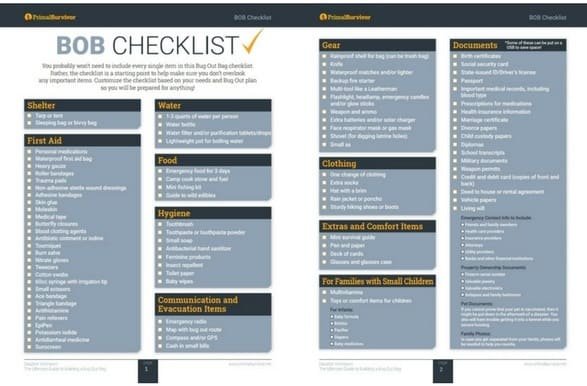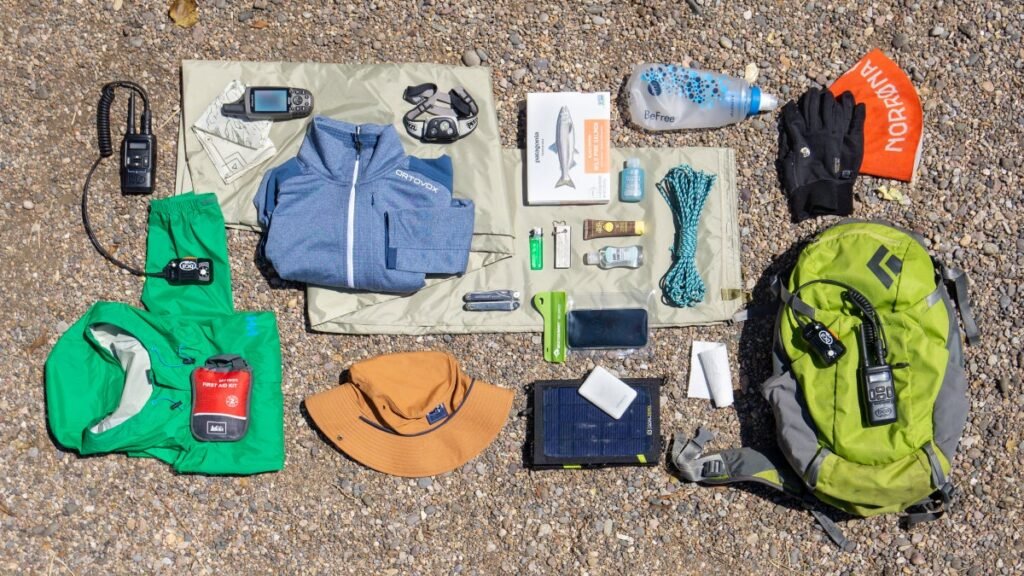Have you ever wondered how to create a bug-out plan and when it’s actually necessary to use it? Well, look no further because this article will provide you with all the information you need. Whether you’re preparing for natural disasters, civil unrest, or any other potential emergency situation, having a bug-out plan in place can be a lifesaver. In this article, you’ll learn the important steps to take when creating a bug-out plan, including gathering essential supplies, identifying safe locations, and establishing communication methods. So, if you want to be prepared for the unexpected, keep reading, and you’ll soon have all the tools you need to create a comprehensive bug-out plan.
Are you curious about how to create a bug-out plan and when it’s appropriate to use it? If so, this article is perfect for you. Whether you live in an area prone to natural disasters or you simply want to be prepared for any emergency situation, having a bug-out plan is crucial. In this article, we’ll guide you through the process of creating a bug-out plan step by step. From determining what supplies you’ll need to identifying safe locations, you’ll learn all the necessary information to create a solid plan. So, if you’re ready to take your preparedness to the next level, keep reading.

This image is property of www.primalsurvivor.net.
What is a bug-out plan?
Defining a bug-out plan
A bug-out plan, also known as an evacuation plan, is a predetermined set of procedures and actions that individuals or families take to quickly and safely leave their homes and relocate to a more secure location during times of emergency or crisis. It serves as a roadmap for navigating potential threats and ensuring the protection and well-being of oneself and loved ones.
Purpose of a bug-out plan
The primary purpose of a bug-out plan is to enable individuals and families to respond efficiently and effectively to emergency situations that may require them to evacuate their homes. By having a well-thought-out plan in place, individuals can minimize confusion, panic, and potential risks during times of crisis. A bug-out plan provides peace of mind by allowing individuals to feel prepared, capable, and in control of their own safety and security.
Why do you need a bug-out plan?
Natural disasters
One of the main reasons why having a bug-out plan is essential is the occurrence of natural disasters. Earthquakes, hurricanes, floods, wildfires, and tornadoes can strike unexpectedly, leaving individuals and families with little time to react. In such situations, a bug-out plan can mean the difference between life and death. It ensures that individuals have a plan in place to evacuate to a safer location and have the necessary supplies and resources to sustain themselves until the situation stabilizes.
Civil unrest or societal collapse
Another reason to have a bug-out plan is the potential for civil unrest or societal collapse. While these scenarios may be less common, they can still occur. Political turmoil, rioting, or large-scale conflicts can disrupt law and order, making certain areas unsafe for individuals and their families. In such situations, a bug-out plan allows for a swift and safe exit to a more secure location with the necessary provisions to ride out the turmoil.
Personal emergencies
Bug-out plans are not solely reserved for large-scale emergencies; they can also be used for personal emergencies. Suppose you or a family member faces an immediate threat due to a home invasion, fire, or any other dangerous situation. In that case, having a bug-out plan ensures that you have a well-defined course of action to follow, allowing you to quickly and safely remove yourselves from harm’s way.
Creating a bug-out plan
Assessing potential threats
To create an effective bug-out plan, the first step is to assess potential threats in your area. Consider the types of natural disasters that are prevalent in your region, such as earthquakes or hurricanes. Additionally, research specific risks, such as proximity to industrial facilities or areas prone to civil unrest. Understanding the potential threats will help you tailor your bug-out plan to suit your circumstances.
Identifying evacuation routes
Once you are aware of the potential threats, the next step is to identify evacuation routes. Familiarize yourself with multiple routes that lead to safer areas, considering different modes of transportation. Take into account alternate routes in case primary roads are blocked or inaccessible. It is also important to account for traffic patterns during peak evacuation times to ensure a smooth and efficient exit.
Gathering essential supplies and resources
A bug-out plan should include a comprehensive list of essential supplies and resources that you need to have on hand. This includes food, water, medication, clothing, bedding, and hygiene items. Aim to have enough supplies to sustain yourself and your family for at least 72 hours, but ideally for a longer duration. Consider the needs of every family member, including infants, elderly individuals, and those with special medical conditions.
Establishing communication methods
Communication is crucial during emergency situations. Ensure that your bug-out plan includes various methods of communication. This can range from cell phones and walkie-talkies to portable radios and satellite phones. Familiarize yourself with the functionality and limitations of each method, and ensure that you have backup power sources or extra batteries available. Establish a designated location or frequency to communicate with other family members or group members.
Preparing emergency contacts
Create a list of emergency contacts that you can reach out to during times of crisis. This should include family members, friends, neighbors, and local authorities. Share this list with all family members, ensuring that everyone knows how to contact these individuals in case you get separated during the evacuation. It is also advisable to inform trusted individuals outside of your immediate area about your bug-out plan and where you plan to relocate, providing them with necessary contact information.
When should you use a bug-out plan?
Imminent danger or threat
A bug-out plan should be utilized when there is an imminent danger or threat to your safety and well-being. This can include situations where you receive evacuation orders from local authorities, when you are in immediate proximity to a natural disaster, or if you become aware of potential civil unrest or societal collapse. It is crucial to trust your instincts and take action if you feel that your safety is at risk.
Disrupted infrastructure or services
A bug-out plan may also be necessary when there is a significant disruption to infrastructure or essential services, such as power outages or water supply issues, that make your current location uninhabitable or unsustainable. In such cases, having a bug-out plan allows you to relocate to a place where these services are intact and readily available.
Loss of shelter or basic necessities
If you find yourself in a situation where you have lost your shelter or access to basic necessities, such as food, water, or medical supplies, it may be time to execute your bug-out plan. Whether it’s due to a natural disaster or any other emergency, having a well-prepared bug-out plan ensures that you are not left vulnerable and are able to secure alternative shelter and essential resources.

This image is property of i.visual.ly.
Bug-out plan considerations
Accounting for special needs or medical conditions
When creating a bug-out plan, it is essential to account for any special needs or medical conditions within your family or group. This can include individuals with physical disabilities, chronic illnesses, or allergies. Make sure to have extra supplies of necessary medications, adaptive equipment, and any specific accommodations that may be required.
Including plans for pets
If you have pets, it is crucial to include them in your bug-out plan. Have a plan in place for their evacuation, including transportation, food, water, and any other necessary supplies. Identify pet-friendly shelters or accommodations in advance, as not all emergency shelters allow animals. Ensure that your pets are properly identified with tags containing your contact information and microchipped if possible.
Planning for long-term survival
While bug-out plans typically prioritize short-term survival, it is advisable to consider long-term survival as well. If the emergency or crisis persists for an extended period, you may need to adapt and sustain yourself and your family for a more extended duration. This may involve learning additional survival skills, such as hunting, fishing, or gardening, and stockpiling additional supplies, such as seeds, tools, and fuel.
Coordinating with family or group members
If you are part of a family or group, coordination is crucial when creating a bug-out plan. Ensure that all members are familiar with the plan and their roles and responsibilities. Regularly communicate and update each other on any changes or developments. Establish meeting points or rendezvous locations in case you become separated during the evacuation. It’s essential to work together as a team to maximize safety and effectiveness.
Implementing your bug-out plan
Regular practice and drills
Once you have created your bug-out plan, it is vital to regularly practice and drill the plan with all family members or group members. This helps familiarize everyone with their roles and responsibilities and allows you to identify any potential gaps or areas of improvement. Conducting drills also helps build confidence and ensures that the plan can be executed smoothly when a real emergency arises.
Updating and revising the plan
A bug-out plan is not a set-it-and-forget-it document. It should be regularly updated and revised to reflect any changes in your circumstances or the potential threats in your area. Review and update your plan at least annually, or whenever there are significant changes in your family composition, living situation, or regional risks. Stay informed about current emergency protocols and incorporate any new information into your bug-out plan.

This image is property of cdn.outsideonline.com.
Resources to aid in bug-out planning
Emergency preparedness websites
There are numerous websites and online resources dedicated to emergency preparedness and bug-out planning. Websites such as Ready.gov, FEMA, and the Red Cross provide valuable information, checklists, and guides to help individuals create robust bug-out plans. Utilize these resources to enhance your plan and ensure that you have covered all essential aspects.
Training courses and workshops
Consider attending training courses or workshops on emergency preparedness and bug-out planning. These courses often provide hands-on experience, expert guidance, and practical tips to help you create and implement an effective bug-out plan. Local community centers, disaster response organizations, and emergency management agencies frequently offer these training opportunities. Take advantage of these resources to improve your preparedness skills.
Common mistakes to avoid in bug-out planning
Failure to account for individual circumstances
One common mistake in bug-out planning is failing to account for individual circumstances. Each person’s situation is unique, and plans should be tailored to accommodate specific needs, limitations, and preferences. Consider factors such as age, physical abilities, and personal preferences when creating your bug-out plan.
Reliance on a single plan or location
Relying solely on a single bug-out plan or location can be a critical mistake. Circumstances can quickly change, and a predetermined plan or location may no longer be viable. Have backup options and alternate routes to ensure flexibility and adaptability in dynamic situations. Consider creating multiple bug-out plans for different scenarios, such as one for natural disasters and another for civil unrest.
Neglecting to consider possible scenarios
When creating a bug-out plan, it is vital to think through different potential scenarios and plan accordingly. Consider worst-case scenarios and outline specific actions to take in each situation. By anticipating different scenarios, you can better prepare and respond effectively, no matter what circumstances arise.

This image is property of www.primalsurvivor.net.
Conclusion
Understanding the importance of a bug-out plan and taking proactive steps to create one is crucial for safeguarding oneself and loved ones during times of emergency or crisis. By defining a bug-out plan, identifying potential threats, gathering essential supplies, and regularly practicing and revising the plan, you can enhance your preparedness and increase your chances of successfully navigating difficult situations. Remember to consider individual circumstances, account for pets, and plan for long-term survival. By being prepared and proactive, you can face emergencies with confidence and peace of mind.
